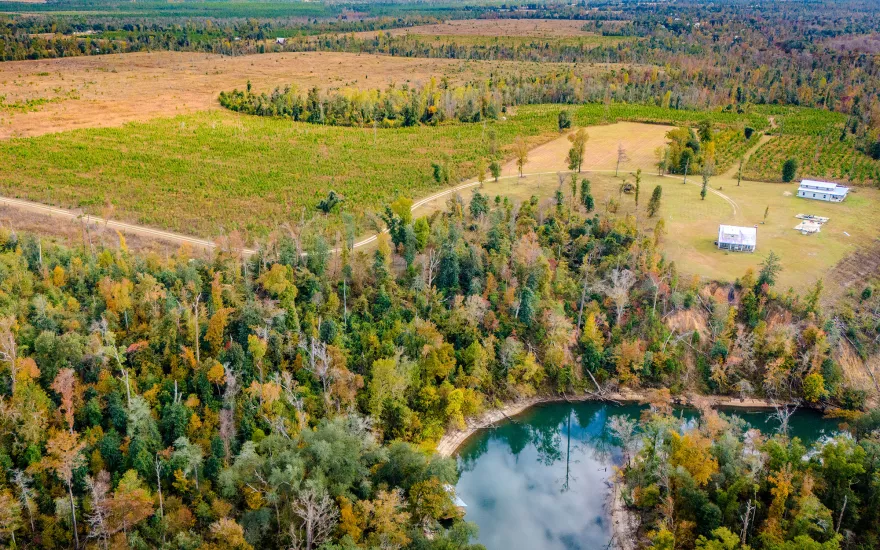Just a fraction of the Southeast’s original forestland remains after relentless deforestation. Restoring the landscape to its former glory will take partnerships and a lot of trees.
Southeastern forests are primarily located on private lands, but their impact reaches beyond property boundaries. Planting trees here ensures a boost to landowner livelihoods, a home for thousands of species, and the opportunity for long-term impact.
Why the American Southeast Is A Priority

Planting with committed landowners
More than 85% of southern forests are on private land, so planting trees here requires landowner buy-in. We have an unmatched network of partners that affords us the access needed for successful reforestation. We also counsel landowners on sustainable land management techniques so they can support their livelihood sellable timber.

Weaving forests into the fabric of the region
Indigenous people and early settlers used trees in the Southeast to lay the groundwork for modern life. Today, the forests remain central to the region’s identity and planting trees fosters local pride. Atlanta, one of the region’s largest cities, is even nicknamed “the city in a forest.” The forest’s resources also provides economic opportunities as well.

Planting longleaf pine makes the region resilient
Longleaf pine lives an average of 250 years, can withstand high winds and resist pests. Low-intensity burns help this fire-adapted species, and their ecosystem thrive. We’ve identified longleaf pine as an ideal species to plant here because its high survivability indicates capability for long-term, positive impact on the region.

Protecting one of the continent’s most biodiverse hotspots
Reforestation is helping preserve the vibrancy of American wildlife. Thanks in part to our work, the native gopher tortoise population made a major comeback and was removed from the endangered species list. By planting trees, we can create more survival success stories because trees serve as habitat to 80% of land-based animals.

Current State
While federal agencies play a key role in reforesting other parts of the country, they’re limited in the privately-owned forests of the Southeast. That’s why we’ve spent decades fostering strong partnerships with landowners to help get forests planted at scale on private property.
Because we’re uniquely positioned to navigate land ownership hurdles, we can more easily address other challenges facing this critical landscape, stretching from Virginia to Texas.
Regional Threats and Challenges
There are some unique challenges to planting in the Southeast, but replanting trees is part of reestablishing long-term strength.
Private land ownership
More than 85% of Southeast forests are privately-owned. That’s why we support landowners, giving them the resources and education to be committed environmental stewards.
Under-protected
Because a majority of Southeast forests are privately-owned, they’re also not federally protected. It leaves existing forests open to deforestation and land degradation.
Land degradation
Some landowners lack the resources or know-how to utilize their forest for its economic advantages. It means they can be financially driven to cut trees and convert the land to other uses, like agriculture.
Natural disasters
Of the 13 major U.S. hurricanes from the last decade, half impacted the Southeast. Trees in this region can help slow strong winds, prevent coastal erosion, and mitigate flooding.
Habitat loss
Rare species like the gopher frog and red-cockaded woodpeckers are being displaced by deforestation. Forests provide unique species – found nowhere else in the world – a secure habitat.

Our Work in the American Southeast
The Arbor Day Foundation has helped plant more than 15 million longleaf pine trees in this region to date. The benefits of trees know no property lines, which is why engaging private landowners is such a critical part of reforesting the Southeast. We’ve established a strong network of landowner groups and are uniquely positioned to connect them to funding, educational resources, and forestry experts. We believe that, together, we can plant a better tomorrow.

Right Trees, Right Place, Right Reason
As a global nonprofit dedicated to planting trees, the Arbor Day Foundation is committed to nurturing crucial forestlands. We leverage cutting-edge science and data to identify ecosystems of global influence, like the American Southeast. We’re using our exclusive forest priority index to elevate our impact through reforestation and mobilize our network of partners to help plant at the speed of a changing world.
Give Today to Shape Tomorrow
The forests of the Southeast have given so much to our history, our culture, and our quality of life. Your support makes a difference. Let’s plant trees to restore this critical forest and create a better future for all of us.






